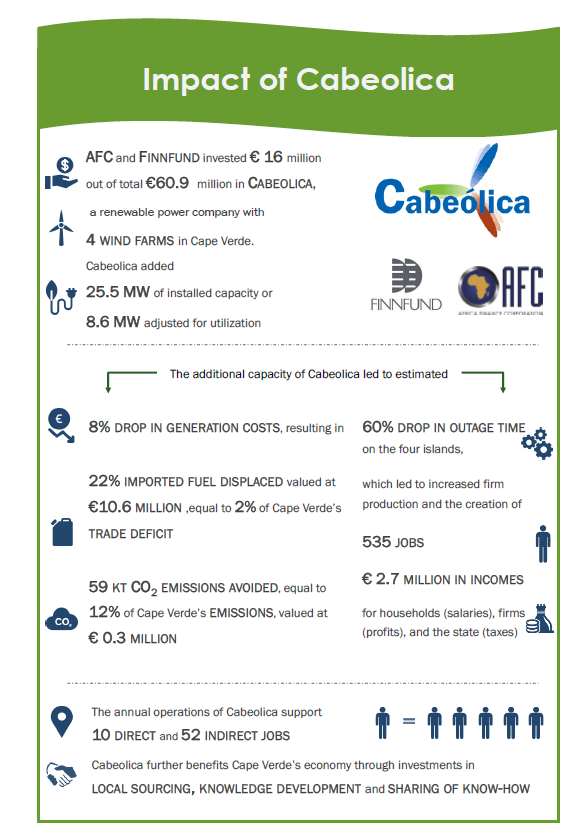Impact study: The Link between Power Investments, Incomes and Jobs in Cape Verde
Project: Cabeólica S.A.
Country: Cape Verde
Sector: Renewable energy
About the Project
Cabeólica wind farms consist of 30 wind turbines on four islands of Cape Verde: Santiago (9.35 MW), Sao Vicente (5.95 MW), Sal (7.65 MW) and Boa Vista (2.55 MW), totalling 25.5 MW. The project company is owned by Africa Finance Corporation (57%), Finnfund (37%), Electra (3.25%), and the Government of Cape Verde (2.75%). Since the beginning of its operations, Cabeólica has generated over 20% of Cape Verde’s annual electricity consumption. Finnfund invested in Cabeólica in 2010.
Why?
Cape Verde is a small state comprising ten islands, approximately 500 km off the west coast of Africa. Total installed power generation capacity has increased from 90 MW in 2009 to 199 MW in 2016. The increase has been driven by investments in thermal power generation and Cabeólica wind farm of 25.5 MW that raised the share of renewable energy generation in Cape Verde from 0 to over 20%.
Despite Cabeólica, a great majority, 80%, of power generation in Cape Verde is still from thermal power plants that use imported diesel or fuel oil. Cape Verde is committed to achieve 100% renewable energy rate by 2025.
Key findings
- The addition of 25.5 MW power generation capacity increased the effective supply of electricity by 14%.
- By adding cheaper renewable energy to the grid, Cabeólica is estimated to have decreased the average electricity generation costs in Cape Verde by nearly 8% or € 0.02/kWh. However, as electricity prices in Cape Verde are not cost-reflective, this reduction has not been reflected consumer electricity prices.
- The shift from thermal to wind power is estimated to have displaced 12% (17 million litres) of Cape Verde’s fuel imports, equalling to € 10.6 million or 2.1% of the country’s trade deficit.
- This has also lowered the overall CO2 emissions by avoidance of 58.7 kt of CO2 emissions, which is approximately 12% of Cape Verde’s total emissions.
- Cabeólica is estimated to have decreased outage time by 60%, leading to 0.8% increase in production time and overall 0.25% in national business production. This translates into 535 jobs and € 2.7 million in incomes.
How?
The study was commissioned by African Finance Corporation and Finnfund, and conducted by Teodora Nenova, Max Markrich and Rene Kim from Steward Redqueen, http://www.stewardredqueen.com/en/home
The study was conducted in spring 2018 and followed a pretested methodology of how power availability and affordability affect economic output. This methodology consists of construction of an electricity price model, an analysis of outage data and estimation of the related economic output and employment increase using an input-output model and employment intensity data.
More information
